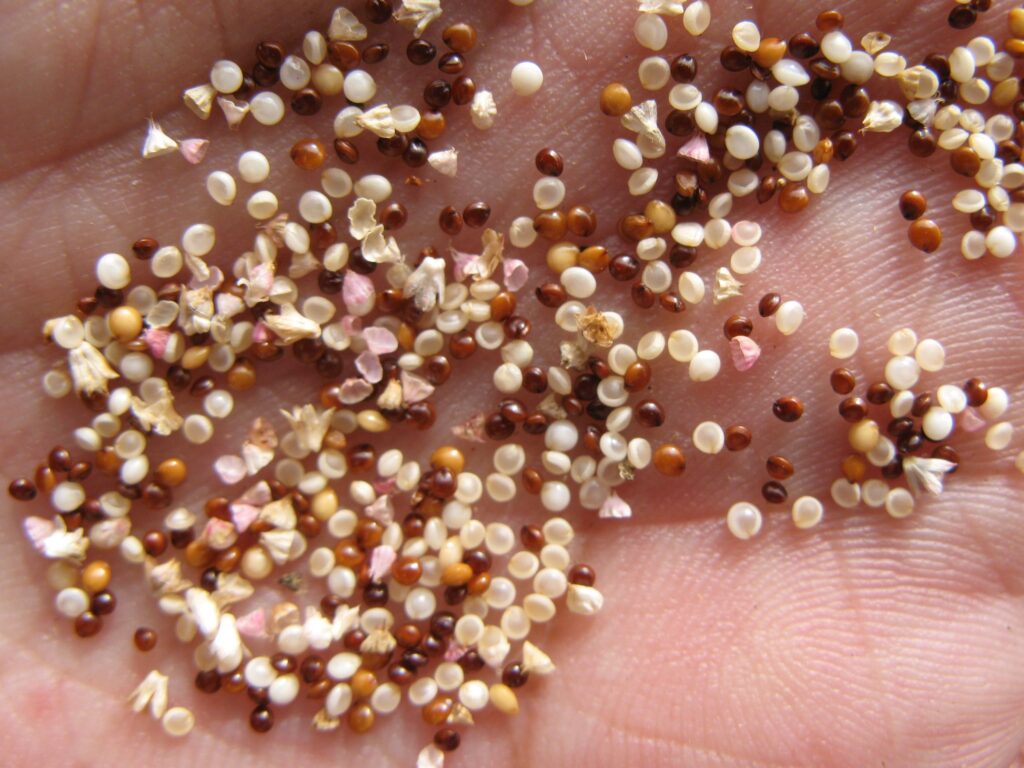Kiwicha:
What is it?, history, cultivation, nutritional value, uses, recipes, and more...
Amaranth, also known as Kiwicha, is a cereal rich in essential amino acids that aids in the nutrition of pregnant mothers and children, as well as the absorption of calcium. Additionally, it promotes the formation of collagen, a crucial substance for bones and connective tissues, including skin, tendons, and cartilage.
Índice
What is Kiwicha?
Kiwicha is a fast-growing dicotyledonous plant from the amaranth family (Amaranthaceae), with purple, red, and golden leaves, stems, and flowers. Its central stem can reach a height of 2 to 2.5 meters, although there are shorter varieties. Its cylindrical branches can start as low as the base of the plant depending on its variety. Striking flowers bloom from the main stem, and in some cases, their inflorescences can measure up to 90 cm. Each panicle contains male and female flowers that self-pollinate or can be pollinated by the wind. The fruits contain a single seed.
The plant adapts easily to different environments, possesses an efficient type of photosynthesis (C4), grows rapidly, and requires minimal maintenance. It thrives at altitudes between 1,400 and 2,400 meters above sea level and, unlike quinoa, does not contain bitter saponins, which makes it favorable for consumption.
Between January and November 2020, our country exported 1,679,717 kilograms of kiwicha (Amaranthus caudatus) valued at US$5,226,252, representing a significant increase compared to 2019 when it was exported for a value of US$1,164,515.
History of Kiwicha
Amaranthus caudatus has been found alongside Andean tombs dating back over five thousand years in present-day Peru. Although considered a rustic crop, it is believed to have been fully domesticated for millennia.
In pre-Columbian times, kiwicha was highly valued in Mexico, where “hostias” made from kiwicha were prepared for the faithful attending magical-religious ceremonies. This practice raised suspicion among the Spaniards, who saw it as a satanic distortion of Catholicism and prohibited its consumption.
During the Viceroyalty period in Peru, colonizers discovered the high value of kiwicha, but since it was consumed by the indigenous people, they decided not to include it in their meals and banned its circulation. Any food that did not have their approval could not be grown or harvested. Many years later, this powerful grain has regained importance within the population.
Kiwicha caught the attention of NASA due to its significant nutritional properties, and it was classified as a CELLS crop (Controlled Ecological Life Support System: the plant removes carbon dioxide from the atmosphere while generating food, oxygen, and water for astronauts). As a result, kiwicha has been cultivated during space travel since 1985, blooming in space during the orbital flight of the Atlantis 71 B spacecraft.

Common Name of Kiwicha
| Spanish | Quihuicha, Chenille, Cresta de gallo, Rabo de gato, Rabo de mono |
| Quechua | Kiwicha, inka hakatu, ataku, sankurachi, jaguarcha, hawarcha (Ecuador), millmi, quymi |
| Aymara | Kiwicha, amarantu, trigu inka, achis, achita, chaquilla, sangoracha, borlas |
| Portugues | Amaranto de cauda. |
| English | Amaranth, love-lies-bleeding, red-hot, cattail, bush green, Inca wheat (normalmente usado para quinua). |
| French | amarante caudeé. |
Scientific Name of Kiwicha
Amaranthus caudatus
Taxonomy of Kiwicha
| Kingdom | Plantae |
| Division | Magnoliophyta |
| Class | Rosopsida |
| Subclass | Caryophyllidae |
| Order | Caryophyllales |
| Family | Amaranthaceae |
| Subfamily | Chenopodioideae |
| Gender | Amaranthus |
| Species | Amaranthus caudatus |
Synonymy of Kiwicha
Amaranthus abyssinicus L.H.Bailey
Amaranthus alopecurus Hochst. ex A.Br. & C.D.Bouché
Amaranthus cararu Moq.
Amaranthus caudatus var. albiflorus Moq.
Amaranthus caudatus var. alopecurus Moq.
Amaranthus caudatus subsp. mantegazzianus (Pass.) Hanelt
Amaranthus caudatus var. maximus (Mill.) Moq.
Amaranthus caudatus subsp. saueri
Amaranthus edulis Speg.
Amaranthus edulis var. spadiceus Hunz.
Amaranthus mantegazzianus Pass.
Amaranthus maximus Mill.
Amaranthus pendulinus Moq.
Amaranthus pendulus Moq.
Euxolus arvensis Rojas Acosta
Etymology of Kiwicha
Amaranthus: the generic name comes from the Greek amaranthos, which means “unfading flower.”
Caudatus: Latin epithet meaning “tailed” or “with a tail.”
Cultivation, Distribution, and Habitat of Kiwicha
- Habitat
- Distribution
- Cultivation
Habitat of Kiwicha
Kiwicha grows in the lowlands and highlands of Colombia, Peru, Ecuador, Bolivia, and Argentina. Around 1200 varieties are still preserved in the Andes.
Other types of Amaranthus are naturally distributed in southern Russia (Volga Delta), the Middle East (Azerbaijan, Iran), eastern Siberia, China, Pakistan, Bhutan, Nepal, India, Sri Lanka, Japan, Korea, Taiwan, Myanmar, Thailand, Vietnam, Indonesia, Malaysia, the Philippines, New Guinea, and Australia. It has been introduced in the United States and naturalized in parts of southern Europe (Romania) and northeastern Africa (Egypt) since ancient times, where it is cultivated for its edible seeds, known as the renowned "faba aegyptiaca" by the Romans.
Most kiwicha varieties require short daylight periods. They can develop in areas with as little as 200 mm of rainfall. It can tolerate long periods of drought once it has established in the soil.
Kiwicha is the only amaranth that thrives above 2,500 meters in the Andes. It typically grows between 1,500 and 3,600 meters, although commercial varieties are cultivated at sea level near Lima, Peru.
Kiwicha and other amaranths adapt to various climates and tolerate adversities by converting the rough materials of soil, sunlight, and water into the plant through the process of photosynthesis.
While it can withstand low temperatures, it does not tolerate frost. Some species have been found to withstand temperatures as low as 4°C. Its ideal temperature range is between 21 and 28°C, but it can also develop at high temperatures between 35 and 40°C.
The ideal soil type for kiwicha growth contains a wide variety of nutrients, including sandy soils with high humus content.
Kiwicha cultivation is easy to establish; the seeds are scattered in the field or sown on slopes. Mechanical seeders used for wheat can be adapted to plant kiwicha seeds. The seeds can germinate in as little as three days, but the plants take time to sprout and are easily invaded by weeds. Once established, they grow rapidly, and their maintenance is relatively simple.
Most kiwicha species mature in 4 to 6 months; however, in some Andean regions, maturation can take approximately 10 months. The average productivity is 1,000 to 3,000 kg of seeds per hectare.
Distribution of Kiwicha
Kiwicha (amaranth) is a crop that is spreading worldwide, found in more than 70 countries. It is essential to note that 92% of its production is in Bolivia and Peru as of 2008, while the remaining 8% is mainly in the United States, Ecuador, Argentina, and Canada.
The main producing countries are Argentina, Bolivia, Ecuador, the United States, Chile, Colombia, and Peru, although its cultivation is expanding to various countries in Europe and Asia, with high levels of yield.
The cultivation of kiwicha is expanding and is now grown in more than 70 countries, including France, England, Sweden, Denmark, the Netherlands, and Italy. It is also being successfully developed in Kenya, India, and the United States.
Production Regions: In the Andes of Argentina, Bolivia, Chile, Colombia, Ecuador, and Peru.
In our country, kiwicha is cultivated in 19 out of the 24 departments; however, the region of Puno has the highest proportion of national production according to statistical records.
Faced with the challenge of increasing the production of quality food to feed the world's population in the context of climate change, kiwicha is an alternative for countries experiencing food insecurity.
Cultivation of Kiwicha
Sunlight Requirement: Kiwicha exhibits various photoperiods, from short-day requirements for flowering near the equator to insensitivity to light conditions for development in Chile.
Precipitation: Kiwicha requires 300 to 1,000 mm of rainfall; the pluvial conditions vary depending on the species and/or country of origin. Southern Chilean varieties need more rain, while those from the Altiplano need less. In general, it grows well with a good distribution of rain during its growth and development, and it can withstand dry conditions, especially during its maturation and harvest.
Altitude: It grows from sea level in Chile and Peru to 4,000 meters in the Andes, but it generally thrives between 2,500 and 4,000 meters above sea level.
Low Temperatures: Kiwicha tolerates a wide range of climates and is not affected by cold climates (-1°C). However, the plant's flowers are sensitive to cold, so mid-season frosts in the Andes can destroy the crop.
High Temperatures: The plant tolerates temperatures over 35°C but does not thrive in such conditions.
Soil Types: Kiwicha can grow in a wide variety of soils with a pH ranging from 6 to 8.5.
Management Techniques: In the Andes, kiwicha is usually sown directly on the ground. Sometimes it is sown in narrow and shallow rows. The seedbed must be well-prepared and well-drained as the seeds can easily die from waterlogging. The plant grows quickly, with a growth period ranging from 90 to 120 days, depending on the varieties sown and the temperature. Mechanized production is becoming successful in South America. Machinery used for grains and oilseeds can be used for quinoa with minimal or no modifications.
Limitations and Diseases: Pests or diseases do not cause significant losses. The main problem is weed growth near the crop.
Harvest: Kiwicha has extremely variable maturity periods, which makes mechanization challenging. For many years, the harvest has been done by hand by farmers, and machinery is rarely used. The average productivity is approximately 3,000 kg/ha, and sometimes it can reach up to 5,000 kg/ha, comparable to wheat harvests in the Andean region. After harvesting the seeds, they are threshed, ventilated to remove the husk, and then carefully dried because they germinate rapidly when stored. Quinoa seeds must be processed to remove the bitter saponins. In home conditions, this is done by soaking, washing, and rubbing the seeds. Commercially, mechanical grinding or combined washing and grinding are the most common methods.
Geographic Distribution of Kiwicha

Cajamarca, Junín, Ancash, Huancavelica, Cuzco, Ayacucho, Arequipa
Seasonal Availability of Kiwicha
- May, June, July, August
Varieties of Kiwicha
More than 1,200 ecotypes of kiwicha have been categorized in the Andes. Varieties are known based on grain and panicle shape, plant color, and other characteristics.
The most well-known varieties of kiwicha are:
-
Noel Vietmeyer
-
Oscar Blanco
-
Chullpi
-
Noel Vietmeyer
-
Alan García
-
INIA 414 - Taray
-
INIA 413
Nutritional Value of Kiwicha
Kiwicha is an excellent source of essential amino acids, including lysine, a recommended amino acid for the nutrition of pregnant mothers and infants. Additionally, it aids in collagen formation, the most abundant protein in the body and the main component of connective tissues found in various parts of the body, including tendons, ligaments, skin, and muscles.
This Andean grain contains high nutritional value of proteins and minerals such as calcium, phosphorus, potassium, zinc, among others, which are essential for strengthening the immune system and supporting the development of bones, teeth, and blood. It also provides vitamin C and B-complex vitamins such as thiamine (B1), riboflavin (B2), and niacin (B3). One hundred grams of kiwicha provide 428 calories, of which 70% are carbohydrates, 14.5% are proteins, and 7.8% are fat.
Kiwicha seeds contain 15 to 18% protein and have a very fine and soft fiber compared to other cereals like wheat, so there is no need to separate it from the flour. Together, they provide a great source of energy. Its levels of vitamin A, also known as retinol, provide antioxidant properties and help the proper functioning of tissues like the retina.
Moreover, an infusion made from the stems of this plant serves as a laxative and helps alleviate rheumatic and menstrual pains. Consuming 3 grams of roasted kiwicha can help prevent constipation.
Health Benefits of Kiwicha
Kiwicha is a highly nutritious grain due to its high content of calcium, phosphorus, iron, among others.
Contraindications or Side Effects
Although kiwicha does not present any contraindications, it may cause some negative effects in a small proportion of people. Kiwicha can cause discomfort for individuals with irritable bowel syndrome, intestinal irritations, and diarrhea. It can also cause irritation or abdominal cramps in people not accustomed to consuming fiber.
Additionally, excessive consumption of kiwicha can lead to weight gain since 100 grams of these seeds contain almost 400 calories.
| 10 Porciones por Kilogramo | |
| Tamaño de porción | 100g |
| Cantidad por porción Calorías |
351 |
| Cantidad por 100g | |
| Energía | 1,469 kJ |
| Grasa Total | 6.6 g |
| Sodio | ● |
| Carbohidratos totales | 69.1 g |
| Carbohidratos disponibles | 59.8 g |
| Fibra Dietaria | 9.3 g |
| Proteínas | 12.8 g |
| Calcio | 236 mg |
| Fósforo | 453 mg |
| Zinc | 2.68 mg |
| Hierro | 7.32 mg |
| Potasio | ● |
| Agua | 9.2 g |
| Cenizas | 2.3 g |
| Vitamina A | 10 μg |
| Tiamina (B1) | 0.09 mg |
| Riboflavina (B2) | 0.18 mg |
| Niacina (B3) | 1.58 mg |
| Vitamina C | 1.30 mg |
| Acido Fólico (B9) | ● |
| β-Caroteno | 57 μg |
| Fuente: Tablas peruanas de composición de alimentos – Centro Nacional de Alimentación y Nutrición – Ministerio de Salud – Perú | |
Derived Products and Ways of Consuming Kiwicha
Uses of Kiwicha
Kiwicha is a highly nutritious culinary ingredient used in cooking and baking.
- Culinary
- Medicinal
- Industrial
- Ritual
Culinary Use of Kiwicha
Kiwicha offers multiple ways of consumption and adapts well to both sweet and savory dishes. The seeds can be boiled and easily taken as an infusion. Kiwicha flour is often mixed with other ingredients like milk or oats for breakfast. Additionally, there are preparations that combine it with other grains such as quinoa and fava beans.
It is also used as an alternative to replace traditional flour and is used in the preparation of cakes and bread, like flatbread, tortillas, and chapatis.
A flour made with 80% wheat flour and 20% kiwicha flour gives the bread dough the right amount of yeast and higher nutritional value than if made solely with wheat flour. Kiwicha is used in various forms, such as whole grains, flour, toasted grains, or flakes, in soups, stews, pancakes, porridge, bread, and salads.
Moreover, a traditional use in several departments of Peru is the making of kiwicha balls as snacks.
The leaves are consumed cooked, added to soups.
The stems have started to be used in the preparation of rehydrating beverages.
The grains or seeds serve for the elaboration of a variety of cooked or toasted dishes, as well as in flour form.
Furthermore, kiwicha residues can be used as fodder for livestock since their nutritional value is higher than in other Andean crops.
Medicinal Use of Kiwicha
Kiwicha is employed in various communities for bladder inflammation, rheumatism, and menstrual pains. The roots are used against diarrhea, and the stems are used as a laxative. At other times, the leaves are used for mouthwash or to alleviate throat irritation. It is even utilized to stabilize glucose and fat levels in the blood of obese, hypertensive, high-cholesterol, and constipated patients.
Moreover, due to its aspartic acid content, Kiwicha can help absorb toxins from the bloodstream, combating liver and kidney diseases.
Other key health benefits of kiwicha include:
High nutritional value, especially in proteins, fiber, iron, phosphorus, calcium, and amino acids (kiwicha grains).
Contributes to bone and muscle development and strength (grains).
Promotes mental development and stimulates growth (grains).
Stimulates bowel function (grains).
Industrial Use of Kiwicha
Currently, various methods are being developed in Peru to extract betalain, the red kiwicha variety, from which a dye of the same color is obtained. Unlike synthetic dyes, this one is non-toxic, making it an essential substitute in pastry-making.
Ritual Use of Kiwicha
The Incas attributed magical powers to quinoa, turning the planting and harvesting of the crop into religious festivities. However, when the Spanish conquistadors arrived in the Andean countries and learned about the importance of quinoa, they rejected and prohibited it. It is believed that they acted this way out of fear of the "magic quinoa" since its consumption and religious ceremonies could grant indigenous people extraordinary powers and endanger their conquest.
Currently, it is used in traditional Andean rituals as an offering to Pachamama, and the "Quinua Mama" festival is still celebrated in Puno. According to Inca traditions, at the beginning of the quinoa harvest in the Andes, ancient Peruvian farmers would perform a special invocation to "Quinua Mama," the pre-Hispanic goddess of the grain, for an abundant harvest. This ritual involved toasting the first seeds while girls and women made dolls with quinoa leaves and grains, which were preserved for a year and then burned as a sign of renewal.



